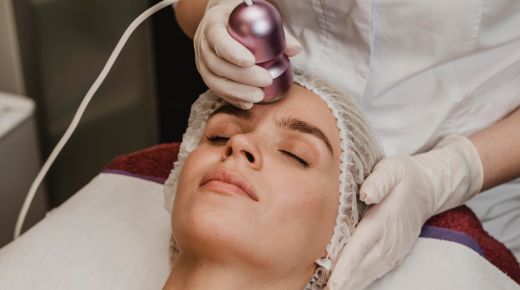Beauty
How to Exfoliate Your Face – A Complete Guide for Glowing Skin

Exfoliation is a key step in any skincare routine, crucial for achieving smooth, glowing skin. By removing dead skin cells, exfoliation helps to unclog pores, reduce acne, and allow skincare products to penetrate deeper into the skin. In this guide, we’ll explore the best methods for exfoliating your face, the different types of exfoliants, and tips for ensuring you achieve the best results without damaging your skin.
Understanding Exfoliation – Why It Matters
How to exfoliate face Your skin naturally sheds dead cells to make room for new ones, but sometimes, this process needs a little help. When dead skin cells accumulate on the surface, they can cause your complexion to look dull, contribute to clogged pores, and even lead to breakouts. Exfoliation helps to clear away these cells, revealing the fresh, healthy skin underneath.
Exfoliation also stimulates blood circulation, promoting a brighter complexion and an even skin tone. Additionally, by removing the barrier of dead cells, your moisturizers and serums can penetrate more effectively, making your overall skincare routine more effective.
Types of Exfoliants: Physical vs. Chemical
Exfoliants come in two main types: physical and chemical. Each type has its benefits and is suitable for different skin types and concerns.
1. Physical Exfoliants
Physical exfoliants involve using a product with small granules or a tool to manually slough off dead skin cells. Examples include:
- Scrubs: These contain small particles like sugar, salt, or microbeads that physically rub away dead skin cells.
- Brushes and Sponges: Tools like facial brushes or konjac sponges can be used to gently exfoliate the skin.
- Exfoliating Cloths or Pads: These are textured cloths or pre-soaked pads that physically remove dead skin.
Benefits of Physical Exfoliants:
- Instant results: Physical exfoliation offers immediate smoothing of the skin.
- Customizable: The intensity can be adjusted based on the pressure applied.
Considerations:
- Can be harsh: If overused or applied with too much pressure, physical exfoliants can cause microtears in the skin, leading to irritation.
- Not suitable for all skin types: Those with sensitive or acne-prone skin may find physical exfoliants too abrasive.
2. Chemical Exfoliants
Chemical exfoliants use active ingredients like acids or enzymes to dissolve dead skin cells without the need for scrubbing. Common types of chemical exfoliants include:
- Alpha Hydroxy Acids (AHAs): AHAs like glycolic acid and lactic acid work on the surface of the skin to gently exfoliate. They are water-soluble and best for normal to dry skin types.
- Beta Hydroxy Acids (BHAs): Salicylic acid is a common BHA that penetrates deeper into the pores, making it ideal for oily or acne-prone skin.
- Enzymes: Derived from fruits like papaya or pineapple, enzyme exfoliants are gentle and ideal for sensitive skin.
Benefits of Chemical Exfoliants:
- Even exfoliation: Chemical exfoliants work evenly across the skin, reducing the risk of over-exfoliation.
- Suitable for various skin types: With different options available, chemical exfoliants can be tailored to specific skin needs.
Considerations:
- Requires careful use: It’s essential to use chemical exfoliants as directed to avoid irritation or sensitivity, especially when using acids.
- May cause sensitivity to sunlight: Some chemical exfoliants can increase the skin’s sensitivity to the sun, so using sunscreen is crucial.
How to Choose the Right Exfoliant for Your Skin Type
Selecting the right exfoliant depends on your skin type, concerns, and how your skin reacts to different products. Here’s a quick guide:
- Sensitive Skin: Opt for gentle enzyme exfoliants or low-concentration AHAs. Avoid harsh physical exfoliants.
- Dry Skin: AHAs like lactic acid are ideal as they exfoliate while also providing hydration.
- Oily or Acne-Prone Skin: BHAs, especially salicylic acid, help to clear out clogged pores and reduce breakouts.
- Normal or Combination Skin: You can experiment with both physical and chemical exfoliants, but it’s best to alternate to avoid over-exfoliation.
How Often Should You Exfoliate?
The frequency of exfoliation depends on your skin type and the exfoliant used. Here are general guidelines:
- Sensitive Skin: Exfoliate once a week with a gentle exfoliant.
- Dry Skin: 1-2 times a week with a hydrating exfoliant.
- Oily Skin: 2-3 times a week, focusing on areas prone to congestion.
- Normal/Combination Skin: 2 times a week, alternating between physical and chemical exfoliants.
Over-exfoliation can lead to irritation, dryness, and even damage the skin barrier, so it’s essential to listen to your skin and adjust your routine as needed.
Step-by-Step Guide to Exfoliating Your Face
- Cleanse Your Skin: Start with a gentle cleanser to remove any makeup, dirt, or oil. This ensures that your exfoliant can work effectively.
- Apply the Exfoliant:
- For Physical Exfoliants: Take a small amount of the product and gently massage it onto damp skin in circular motions. Be careful not to apply too much pressure.
- For Chemical Exfoliants: Apply a thin layer of the product evenly across your face, avoiding the eye area. Follow the product instructions for the recommended duration.
- Rinse Thoroughly: Wash off the exfoliant with lukewarm water. Ensure that no residue is left behind, especially with physical exfoliants.
- Follow with a Toner (Optional): If you use a toner, apply it after exfoliation to help balance your skin’s pH.
- Moisturize: After exfoliating, it’s crucial to restore moisture to your skin. Choose a hydrating moisturizer to lock in moisture and soothe your skin.
- Apply Sunscreen: If you’re exfoliating in the morning or during the day, always follow up with sunscreen. Exfoliation can make your skin more sensitive to the sun, increasing the risk of UV damage.
Common Exfoliation Mistakes to Avoid
- Over-Exfoliating: One of the most common mistakes is exfoliating too often. Over-exfoliation can strip the skin of its natural oils, leading to irritation, dryness, and breakouts.
- Using the Wrong Exfoliant: Not all exfoliants are created equal. Using a product that’s too harsh for your skin type can cause more harm than good. Always choose an exfoliant suited to your skin’s needs.
- Ignoring the Neck and Décolletage: Your face isn’t the only area that benefits from exfoliation. Remember to exfoliate your neck and décolletage to maintain an even complexion.
- Exfoliating on Broken or Irritated Skin: Avoid exfoliating if your skin is broken, sunburned, or experiencing a flare-up of conditions like eczema or rosacea. This can exacerbate the problem and delay healing.
- Skipping Sunscreen: Exfoliation can increase your skin’s sensitivity to the sun. Skipping sunscreen can lead to sunburn, hyperpigmentation, and other forms of skin damage.
DIY Exfoliants: Natural Alternatives for Gentle Exfoliation
For those who prefer natural skincare, there are several DIY exfoliants you can make at home using ingredients from your kitchen:
- Sugar Scrub: Mix sugar with honey and a bit of olive oil for a hydrating exfoliant that leaves your skin smooth and moisturized.
- Oatmeal Scrub: Ground oats mixed with yogurt or milk make for a gentle exfoliant that’s perfect for sensitive skin.
- Coffee Scrub: Used coffee grounds mixed with coconut oil can help to exfoliate and tighten the skin, reducing the appearance of cellulite.
Conclusion: Achieving Radiant Skin Through Proper Exfoliation
Exfoliating your face is a crucial step in maintaining healthy, glowing skin. By understanding the different types of exfoliants and how to use them properly, you can enhance your skincare routine and achieve a smoother, brighter complexion. Remember to choose the right exfoliant for your skin type, exfoliate at the right frequency, and always follow up with moisturizer and sunscreen to protect and nourish your skin. With consistent and mindful exfoliation, radiant skin is within your reach.
Beauty
Beyond Beauty: The Benefits of Morpheus8 Microneedling Treatment

In the quest for youthful and radiant skin, many individuals are turning to innovative cosmetic treatments. Among the various options available, Morpheus8 microneedling treatment has emerged as a favored choice for those seeking effective results with minimal recovery time. This advanced procedure uniquely combines microneedling and radiofrequency energy to target deeper skin layers, offering comprehensive benefits.
This blog post delves into why Morpheus8 is making waves in skincare, exploring its ability to tighten skin, reduce signs of aging, and improve overall skin health. Read on!
Enhanced Skin Tightening
One of the primary advantages of Morpheus8 is its ability to effectively tighten the skin. As we age, the skin’s natural elasticity decreases, leading to sagging and wrinkles. The combination of microneedling and radiofrequency energy stimulates the production of collagen, a key protein that restores firmness and elasticity. This results in a noticeable improvement in skin texture and a youthful, lifted appearance.
Reduced Fine Lines and Wrinkles
Morpheus8 targets both superficial and deeper layers of the skin, making it particularly effective at diminishing fine lines and wrinkles. By boosting collagen levels, the treatment smooths out these common signs of aging, providing a more youthful and refreshed appearance. Patients often notice that their skin looks more vibrant and smoother, with wrinkles softened over time. At our state-of-the-art skincare clinic, we specialize in non-invasive rejuvenation treatments tailored to your skin type. Our most popular service is Microneedling in Montreal , known for stimulating collagen and improving skin texture.
Improved Skin Tone and Texture
Another appealing benefit of Morpheus8 is its ability to enhance skin tone and texture. This treatment can address a variety of skin issues, including uneven skin tone, large pores, and rough texture. The microneedles create micro-lesions that promote the skin’s natural healing process, resulting in smoother, more even skin. This rejuvenation effect leaves individuals with a radiant and balanced complexion.
Minimal Downtime and Recovery
Unlike more invasive procedures, Morpheus8 offers minimal downtime, positioning it as an attractive option for those with busy lifestyles. While some redness and mild swelling might occur initially, these effects typically subside within a few days. Patients can usually return to their normal activities shortly after treatment, making it a convenient choice for improving their appearance without significant disruption to their daily routine.
Versatility Across Skin Types and Areas
Morpheus8 is suitable for various skin types and ages, providing flexibility in treatment areas. Whether targeting the face, neck, or body, this procedure can address a wide range of concerns. Its versatility makes it a preferred choice for individuals looking to treat multiple areas or specific issues that traditional methods might not address effectively.
Long-lasting Results
The results of Morpheus8 are not only immediate but also long-lasting. While some improvement is visible soon after the treatment, collagen production continues to enhance the skin’s appearance over time. Many patients report seeing optimal results several months post-treatment, with benefits lasting up to a year or more. This longevity establishes Morpheus8 as a worthwhile investment for individuals interested in enduring skin enhancement.
Customizable Treatment Options
Morpheus8 treatments can be tailored to meet individual needs and skincare goals. The depth of the microneedles and the intensity of the radiofrequency energy can be adjusted to suit different skin concerns and desired outcomes. This customization allows practitioners to offer a personalized experience, ensuring each patient receives the most effective treatment for their needs.
Morpheus8 microneedling treatment stands out as a revolutionary option for those seeking comprehensive skin rejuvenation with minimal disruption to their daily routines. Its ability to effectively tighten skin, reduce fine lines and wrinkles, improve skin tone and texture, and offer versatile, long-lasting results makes it a popular choice in the cosmetic world.
However, as with any cosmetic procedure, it’s essential to consult cosmetic professionals in your area, like Vermont Med Spa, to determine if Morpheus8 is the right treatment for your specific needs and skincare goals. A professional will provide personalized guidance, ensuring that you achieve optimal results safely and effectively.
Beauty
The Science Behind Hydrating Creams and Why You Need One

Hydration is one of the most important aspects of maintaining healthy, glowing skin. While drinking enough water is essential, the skin also requires topical hydration to stay balanced and radiant. This is where hydrating creams come into play. These skincare products are formulated to enhance skin moisture levels, providing a protective barrier that locks in hydration. In this article, we’ll explore the science behind hydrating creams and why they’re essential for achieving smooth, soft, and youthful-looking skin.
What is a Hydrating Cream?
At its core, a hydrating cream is a moisturizer designed to boost the skin’s ability to retain moisture. It works by delivering water to the skin’s outer layers and creating a barrier that locks in hydration, preventing moisture loss throughout the day. Hydrating creams typically contain ingredients like humectants, emollients, and occlusives, which work together to attract water, smooth the skin, and lock in moisture.
- Humectants: Ingredients like hyaluronic acid, glycerin, and aloe vera are humectants, which attract water from the environment and the deeper layers of the skin. They play a vital role in keeping the skin plump and hydrated.
- Emollients: These ingredients, such as shea butter and fatty acids, soften and smooth the skin, helping to fill in gaps between skin cells.
- Occlusives: Ingredients like beeswax or dimethicone form a protective barrier on the skin’s surface, sealing in moisture and preventing water loss.
How Does a Hydrating Cream Work?
The skin’s outermost layer, known as the stratum corneum, acts as a barrier to protect against environmental aggressors like pollutants, bacteria, and UV radiation. However, this barrier can easily become compromised due to factors such as weather conditions, sun exposure, and harsh skincare products, leading to moisture loss and a dry, flaky complexion.
A hydrating face cream restores moisture levels by replenishing the skin’s natural water content. Here’s how it works:
- Attracting Moisture: Humectants in hydrating creams draw moisture from the environment and the deeper layers of the skin to the surface, ensuring the skin remains hydrated.
- Sealing in Hydration: Emollients and occlusives work to create a protective layer on the skin’s surface, preventing the water from evaporating. This barrier helps retain moisture, ensuring the skin stays hydrated for longer periods.
- Strengthening the Skin Barrier: Regular use of a hydrating cream improves the skin’s barrier function, making it more resilient to environmental factors that can cause dryness and irritation. By reinforcing this barrier, the skin becomes less prone to dehydration and more capable of maintaining its moisture balance.
Why Skin Moisture Matters
Moisture is crucial for healthy skin. Without proper hydration, the skin can become dry, flaky, and more susceptible to irritation. Lack of moisture also contributes to premature aging, as dry skin tends to show fine lines and wrinkles more prominently. By keeping your skin well-hydrated, you can prevent many common skin issues and maintain a soft, smooth complexion.
The benefits of using a hydrating cream go beyond surface-level moisture. Here’s why hydration is so important for your skin:
- Improves Skin Texture: Well-hydrated skin feels smooth and soft to the touch. When the skin is properly moisturized, it looks and feels healthier because it maintains a more even texture.
- Boosts Elasticity: Hydrated skin is more resilient and elastic, which means it can better bounce back from environmental stressors, such as sun exposure or pollution. Over time, this helps to prevent sagging and loss of firmness.
- Reduces Fine Lines and Wrinkles: Dehydrated skin can make wrinkles and fine lines more noticeable. By keeping the skin hydrated, a hydrating cream plumps up the surface, making wrinkles appear less pronounced.
- Prevents Irritation and Sensitivity: When the skin’s moisture barrier is compromised, it becomes more prone to irritation and sensitivity. Using a hydrating cream helps reinforce this barrier, reducing the likelihood of redness, itching, or inflammation.
- Provides a Protective Barrier: Hydrated skin is better equipped to defend itself against environmental aggressors. When the skin is moisturized, its barrier function is stronger, helping to prevent pollutants and irritants from penetrating the deeper layers of the skin.
Who Needs a Hydrating Cream?
The simple answer is: everyone. Regardless of your skin type—whether it’s dry, oily, sensitive, or combination—using a hydrating cream can benefit your skin’s overall health. However, certain skin types or conditions may have a greater need for targeted hydration:
- Dry Skin: People with dry skin often struggle with a lack of natural oils, which means their skin has difficulty holding onto moisture. For dry skin, a rich, emollient-based hydrating cream is ideal for replenishing lost moisture and creating a protective barrier.
- Oily or Acne-Prone Skin: While it may seem counterintuitive, even oily or acne-prone skin needs hydration. Lack of moisture can trigger the skin to produce excess oil, leading to breakouts. Lightweight, non-comedogenic hydrating creams are perfect for these skin types, as they provide hydration without clogging pores.
- Aging Skin: As we age, our skin naturally loses moisture and elasticity, making hydrating creams essential for maintaining a youthful appearance. Hydration helps plump the skin, reducing the appearance of fine lines and wrinkles.
- Sensitive Skin: People with sensitive skin are more prone to irritation and dryness, which makes hydration particularly important. Using a gentle, fragrance-free hydrating cream can help soothe and protect sensitive skin while maintaining moisture balance.
Incorporating a hydrating face cream into your daily skincare routine is essential for maintaining skin moisture and protecting the skin’s natural barrier. Whether you have dry, oily, sensitive, or aging skin, the benefits of using a hydrating cream are clear—smooth texture, increased elasticity, and long-lasting hydration are just a few of the advantages. By understanding the science behind hydration benefits and choosing the right product for your skin type, you can enjoy healthier, more radiant skin year-round.
Don’t forget that it is very important what you eat. You can combine good food with detox products. It is important for your skin.
Beauty
How to Keep Your Skin Healthy During Menopause
Menopause is a natural stage in a woman’s life that brings significant hormonal changes, many of which affect the skin. As estrogen levels decline during menopause, skin can become drier, thinner, and more prone to wrinkles, sagging, and irritation. These changes can feel overwhelming, but with a targeted skincare routine, you can maintain healthy, glowing skin throughout this phase of life. Here are some essential tips for keeping your skin healthy during menopause.
1. Hydrate, Hydrate, Hydrate
One of the most common skin changes during menopause is increased dryness due to reduced estrogen levels. Estrogen helps to maintain moisture in the skin, and its decline can cause the skin’s natural hydration to diminish. To combat this, it’s essential to incorporate moisture-boosting products into your skincare routine.
Look for moisturizers that contain hyaluronic acid, ceramides, and glycerin, which help retain water and strengthen the skin’s barrier. Applying a rich moisturizer both morning and night will help lock in hydration and keep your skin soft and supple. Consider using a hydrating serum under your moisturizer for an extra moisture boost.
2. Use Gentle Cleansers
As skin becomes more sensitive during menopause, using harsh cleansers can strip away its natural oils and lead to irritation. Switch to a gentle, hydrating cleanser that cleans your skin without causing dryness or damage. Look for cleansers that are fragrance-free and designed for sensitive skin to ensure they do not exacerbate any irritation.
Avoid hot water when cleansing, as it can strip away oils and lead to further dryness. Instead, use lukewarm water and gently pat your skin dry with a soft towel.
3. Incorporate Retinoids
Menopause can lead to a loss of collagen, the protein that keeps your skin firm and youthful. This can result in sagging and the appearance of fine lines and wrinkles. To address these changes, consider incorporating retinoids into your skincare routine. Retinoids, derived from vitamin A, are known to stimulate collagen production and accelerate cell turnover, helping to reduce the signs of aging.
Start with a low-strength retinoid and gradually increase its use to avoid irritation. Retinoids can make the skin more sensitive to the sun, so be sure to apply sunscreen daily when using these products.
4. Prioritize Sunscreen
Sun protection becomes even more important during menopause, as the skin becomes thinner and more vulnerable to sun damage. UV rays can worsen the appearance of fine lines, wrinkles, and age spots, so applying sunscreen is critical.
Opt for a broad-spectrum sunscreen with at least SPF 30, and apply it daily, even on cloudy days. Look for sunscreens that contain antioxidants like cream for skin with vitamin C or green tea extract to provide extra protection against free radical damage. Reapply throughout the day, especially if you’re spending extended time outdoors.
5. Focus on Antioxidants
As the skin ages, it becomes more prone to oxidative stress caused by free radicals from pollution, UV rays, and other environmental factors. These free radicals can accelerate aging and lead to dullness, dark spots, and fine lines. To fight these effects, incorporate antioxidant-rich products into your skincare routine.
Look for serums or creams containing vitamin C, vitamin E, niacinamide, or resveratrol. These antioxidants help neutralize free radicals, brighten the complexion, and protect against environmental damage.
6. Exfoliate Gently
During menopause, cell turnover slows down, which can lead to dull, uneven skin. Regular exfoliation can help remove dead skin cells and reveal a brighter, more youthful complexion. However, because the skin becomes more sensitive during menopause, it’s essential to exfoliate gently.
Opt for a chemical exfoliant with alpha-hydroxy acids (AHAs) like lactic acid or glycolic acid, which exfoliate without harsh scrubbing. Use exfoliants once or twice a week, depending on your skin’s sensitivity, to keep your skin smooth and radiant.
7. Stay Hydrated and Maintain a Healthy Diet
Healthy skin during menopause isn’t just about the products you use—it also comes from within. Drink plenty of water throughout the day to keep your skin hydrated from the inside out. Additionally, focus on a nutrient-rich diet that supports skin health. Include foods rich in omega-3 fatty acids, like salmon and walnuts, to help maintain skin elasticity and hydration.
Foods rich in antioxidants, such as berries, leafy greens, and nuts, can also help protect your skin from damage and promote a youthful glow.
Menopause brings many changes to your skin, but with the right care, you can keep it healthy, hydrated, and youthful. By using gentle, hydrating products, protecting your skin from the sun, incorporating collagen-boosting ingredients like retinoids, and maintaining a healthy lifestyle, you can combat the effects of menopause on your skin. A well-rounded approach to skincare during this phase will help you embrace your skin’s natural beauty and maintain a glowing complexion.


